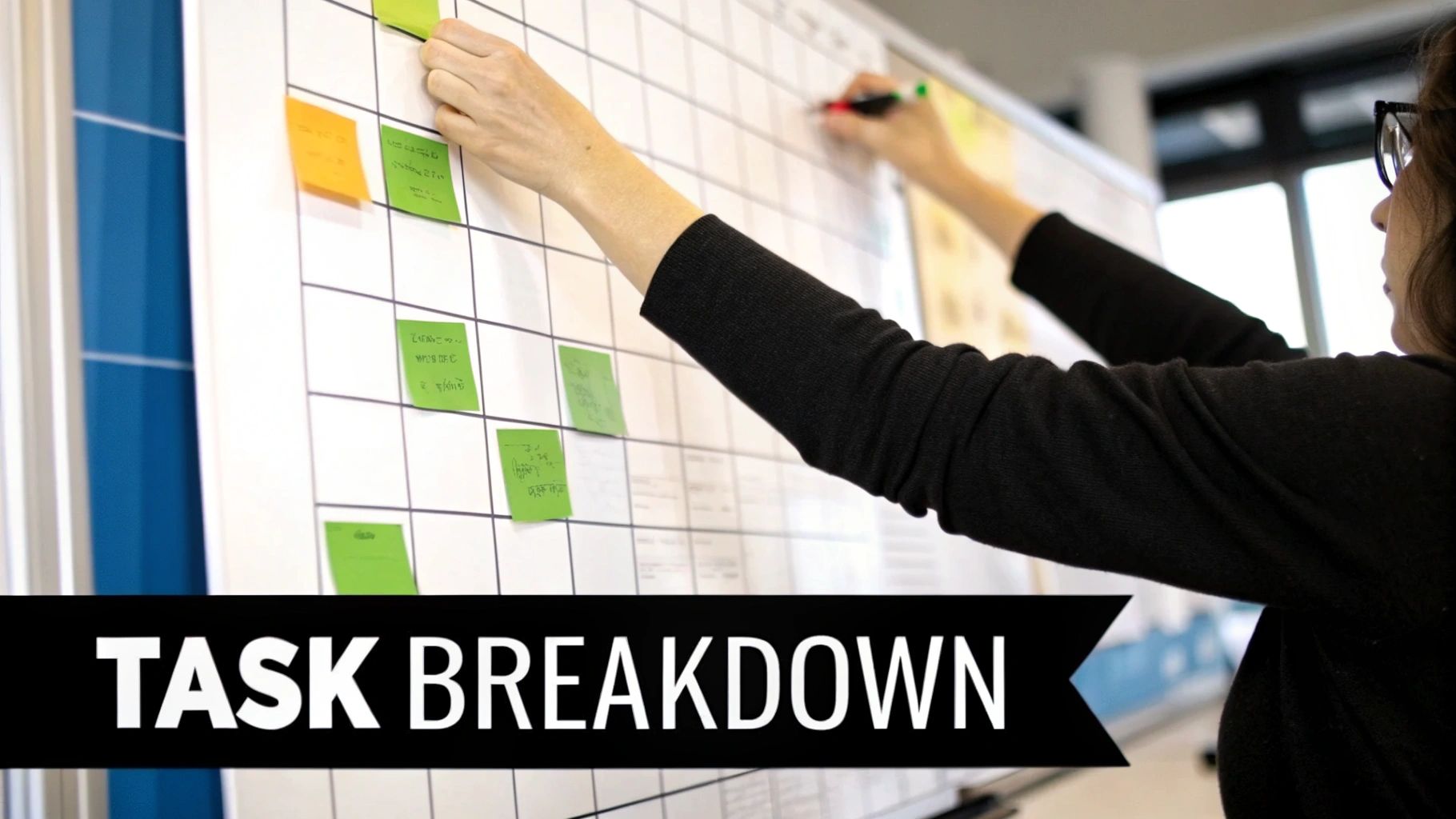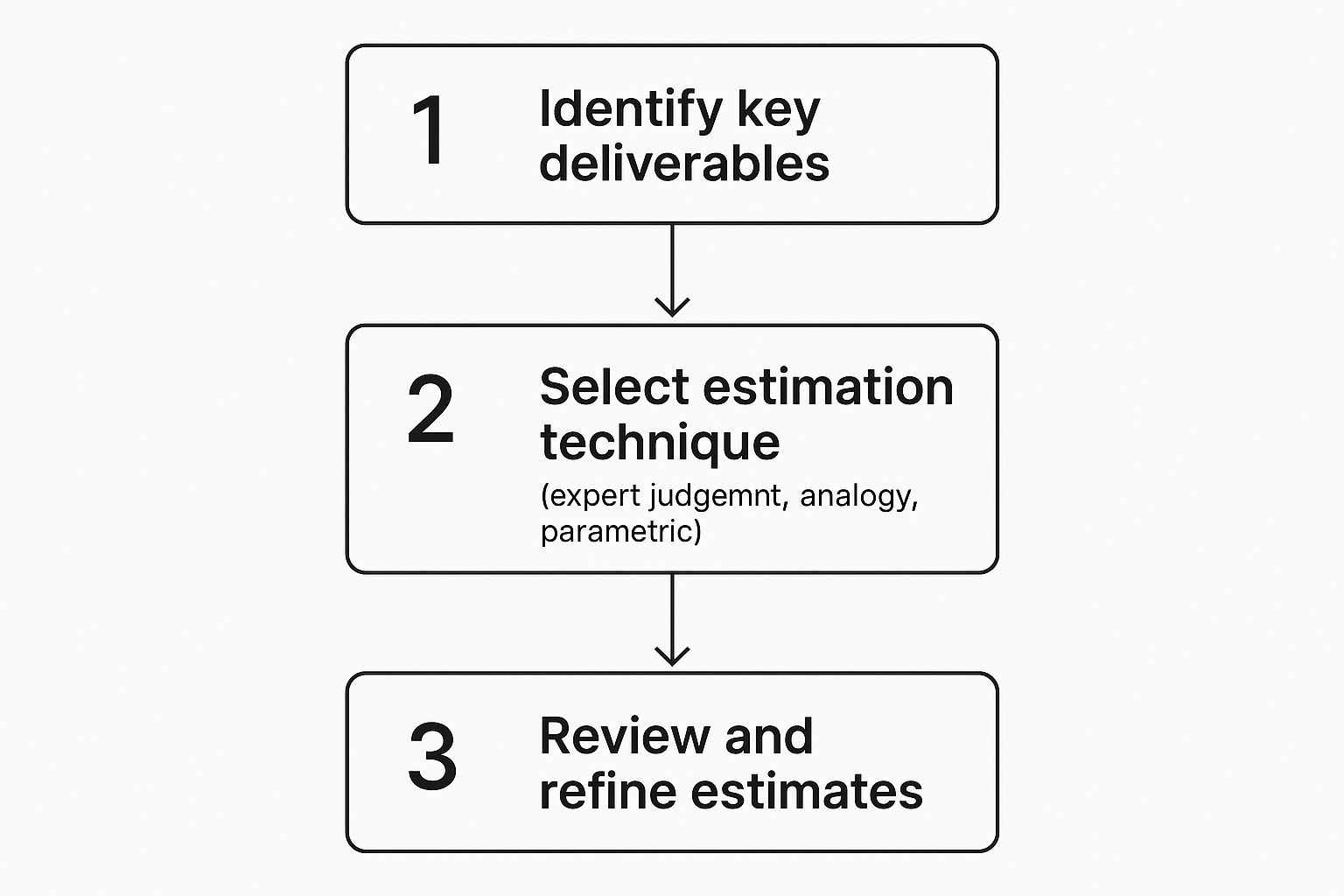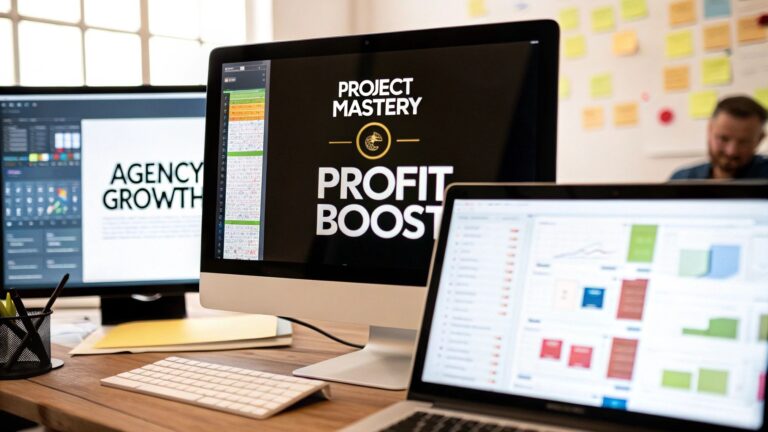Estimating a Software Project Without the Guesswork
Let's be honest: estimating a software project often feels like trying to predict the weather six months from now. It’s not just you—it's a universal challenge across the industry. Software development is fundamentally a process of discovery, not a predictable assembly line. That's why so many teams grapple with it, leading to blown deadlines, busted budgets, and seriously frustrated stakeholders.
The problem isn't a lack of trying. It's the unavoidable, built-in uncertainties that make building software so unique.
Why Software Estimates Are So Hard to Get Right

If you've ever watched an estimate go completely off the rails, you know it's rarely one single thing that causes the crash. It’s usually a perfect storm of technical surprises and human factors.
The Real Reasons Estimates Go Sideways
Here are a few of the most common culprits I've seen derail even the most carefully planned projects:
-
The Ever-Shifting Finish Line: Project scope is almost never set in stone. A new feature request pops up, market demands pivot, or key stakeholders have a sudden change of heart. The goalposts move while you're already sprinting down the field. Learning how to properly document requirements in agile helps, but you have to plan for some degree of change.
-
Ghosts in the Machine (aka Technical Debt): You think you’re just adding a simple button, but then you find a tangled mess of old code left behind from a past project. Suddenly, that "quick fix" requires a major refactor just to get started. These hidden roadblocks can turn a two-hour task into a two-week nightmare.
-
The Human Optimism Gene: We're all wired to be a bit too optimistic. Developers, project managers, everyone—we tend to underestimate how long a complex task will take. This well-documented cognitive quirk, known as the planning fallacy, means initial estimates often fail to account for the real-world friction of bugs, meetings, and other non-coding distractions.
The point of an estimate isn't to carve a number into stone. It's to create a shared understanding of the effort involved and to give everyone a baseline for making smart decisions as the project unfolds.
Think of your estimate as a strategic forecasting tool. The goal isn't absolute perfection; it's reliable predictability. That comes from using the right methods, working with good data, and, most importantly, keeping the lines of communication wide open.
Choosing the Right Estimation Methodology

Once you’ve made peace with the fact that estimation is about forecasting, not fortune-telling, you need to pick the right tool for the job. Not every estimation technique is built the same, and the best one for you hinges entirely on your project's context, your team's culture, and how much you really know about the work ahead.
Picking the wrong method is like trying to measure a room with a kitchen scale—you'll get a number, but it won't mean anything useful. A rigid, long-term model, for example, is a terrible fit for a fast-moving agile team that needs flexibility to thrive.
Collaborative and Relative Sizing Methods
Many modern dev teams have ditched estimating in hours or days. It's just too easy to be wrong. Instead, they've embraced relative sizing, which is all about comparing the complexity of one task to another. This simple shift helps sidestep our natural optimism bias and gets the team talking about real effort and risk, not just time.
Planning Poker is a classic technique that gamifies this process. Everyone on the team uses numbered cards to vote on the "size" of a task. When the numbers are far apart, it sparks an essential conversation. An engineer might point out a hidden technical hurdle that a product manager completely missed, leading to a much more accurate, collective understanding of the work.
This is where Story Points come in. They’re an abstract unit of measure that captures a blend of three key things:
- Complexity: How hard is this to actually build?
- Effort: How much work is there to do?
- Uncertainty: What are the unknowns and potential roadblocks?
By using Story Points, teams can calculate their velocity—the average number of points they complete in a sprint. This historical data is gold. It transforms your estimation process from pure guesswork into a data-driven forecast for what you can realistically deliver next.
Traditional and Algorithmic Models
Of course, not every project is a perfect fit for agile sizing. For larger, more predictable projects with a clear scope from the start, other approaches often make more sense. This is especially true in environments that follow a more structured development path. Our guide on project management waterfall vs agile is a great resource if you're trying to figure out which style fits your organization.
One such method is Function Point Analysis (FPA). This technique measures the business functionality a system provides to the user. Instead of sizing code, it quantifies features like user inputs, outputs, and internal files. It’s a heavy-duty tool, but it's incredibly useful for estimating massive enterprise systems before a single line of code is ever written.
Then you have algorithmic models. For decades, the industry has struggled with estimation, leading to quantitative techniques like COCOMO (Constructive Cost Model). These models, often paired with collaborative methods, make up about 75% of the estimation strategies you'll see discussed in professional circles.
The best methodology isn’t the most complex one; it’s the one your team understands, trusts, and can apply consistently. Your goal is to find a shared language for discussing effort and complexity.
This becomes even more crucial for highly specialized projects. When you're working with AI development services, for instance, the inherent R&D and uncertainty make a solid estimation framework absolutely essential.
Making the Right Choice for Your Team
So, how do you decide which method to use? There’s no silver bullet, but you can narrow down the options by asking a few practical questions. Is your project scope locked in or likely to change? Does your team work in short, iterative cycles or long, planned-out phases?
To help you decide, here’s a quick rundown of the most common techniques.
Comparison of Software Estimation Techniques
| Methodology | Best For | Pros | Cons |
|---|---|---|---|
| Story Points & Planning Poker | Agile teams, projects with evolving scope | Fosters collaboration, avoids time-based pressure | Requires team buy-in, can be abstract for stakeholders |
| Function Point Analysis | Large enterprise systems, waterfall projects | Independent of technology, focuses on user value | Complex to calculate, less adaptable to change |
| Expert Judgment | Early-stage estimates, highly specialized tasks | Quick and simple | Prone to bias, lacks detailed justification |
| COCOMO | Large-scale government or infrastructure projects | Data-driven, standardized | Requires historical data, can be overly rigid |
In the real world, the best approach is often a hybrid. You might lean on expert judgment for a high-level roadmap and then switch to Story Points for your detailed sprint planning. The goal is always the same: choose a method that reduces uncertainty and empowers your team to deliver predictable, high-quality work.
How to Build an Estimation Process You Can Actually Trust
A reliable estimate isn't something you just pull out of thin air in a meeting. It's the final output of a structured and repeatable process. The whole point is to move from a vague idea to a forecast that actually gives people confidence. You're systematically chipping away at ambiguity, turning high-level requirements into a tangible plan your team and stakeholders can get behind.
This isn't a one-and-done deal. It involves identifying every last deliverable, picking the right estimation technique for the job, and then fine-tuning the numbers based on feedback and what you know could go wrong.
This visual gives you a great high-level look at the workflow.

The big takeaway? Estimation is a cycle. You define, you analyze, you refine, and you repeat.
Defining and Deconstructing the Scope
Before you can estimate anything, you have to know what you're building. It sounds obvious, but this is where most estimates go off the rails. Your first job is to get a death grip on the project scope because ambiguity is the absolute enemy of accuracy.
The goal is to break down big, abstract features into small, concrete pieces of work. Two of the best tools for this are the Work Breakdown Structure (WBS) and user story mapping.
-
Work Breakdown Structure (WBS): This is a tried-and-true project management technique. You start with the entire project and break it down hierarchically into smaller, more manageable chunks. For a new e-commerce feature, "User Checkout" might be the top level. That then splits into "Shopping Cart Management," "Payment Processing," and "Order Confirmation." Each of those gets broken down even further into specific development tasks.
-
User Story Mapping: If you're running an agile shop, this is your go-to. It's a visual way to organize the user's entire journey. You map out the major steps a user takes (often called the "backbone") and then slot all the individual user stories and tasks under each of those steps. It's a fantastic way to make sure you don't forget a piece of the user experience and helps everyone see the complete picture.
The more granular you get, the more accurate your estimate will be. A huge, fuzzy task like "Build a dashboard" is impossible to estimate. But when you break it down into "Create API endpoint for user data," "Design a time-series graph component," and "Implement date-range filter," suddenly each piece becomes much, much easier to size up.
Sizing the Work and Projecting Timelines
Okay, so you've got your scope broken down into a neat list of tasks. Now it's time to actually size them up using your chosen methodology—be it story points, function points, or good old expert judgment. This process gives you a total "size" for the project.
But size isn't a timeline. This is a critical distinction.
To turn that abstract size into a real schedule, you have to look at your team's actual, historical capacity. For agile teams, this is where velocity is king. If you know your team consistently completes about 25 story points every two-week sprint and the project scope adds up to 150 points, you can do the math. Your initial timeline estimate is six sprints, or twelve weeks.
Don't forget the "invisible" work! I've seen so many estimates fail because they only account for coding. You have to factor in meetings, code reviews, testing, deployment, and bug fixes. This stuff can easily eat up 20-30% of an engineer's week.
Translating size into a calendar date is the moment your estimate becomes real for stakeholders. It grounds the forecast in what your team has actually done in the past, not just what you hope they can do. From this point, you can start building in smart buffers to handle the surprises that you know are coming.
The Right Tools for the Job: Making Your Estimates Stick

Let's be honest, great estimates don't just magically appear. They are the result of good process supported by good tools. When you're ready to move beyond pure guesswork, you need software that gives you a clear view of your team's past performance. Project management platforms have evolved far beyond digital sticky notes; they're now the engine room for data-driven estimation.
Think of it this way: these platforms are where your team’s work history lives. They track progress, measure team velocity, and store a goldmine of data. When you can easily look back and see that a feature your team called "medium" consistently clocked in around 25 story points, your next estimate for similar work is suddenly on much firmer ground.
Your Project Management Platform is Your Ground Truth
Tools like Jira, Trello, or Asana are fundamental to any modern estimation workflow. Their real power lies in making work visible and, more importantly, measurable. It’s no surprise that 77% of high-performing projects lean on project management software. Yet, as TeamStage.io points out, more than half of all organizations still can't access real-time project KPIs, leaving them guessing in the dark.
These platforms are designed to turn abstract concepts into hard numbers by centralizing everything.
- Velocity Tracking: They do the math for you, calculating how many story points or tasks your team actually finishes in a sprint. This gives you a real-world baseline, not a hopeful guess.
- Cycle Time Reports: You can instantly see how long it takes for a ticket to go from "To Do" to "Done," which is invaluable for spotting hidden bottlenecks that throw estimates off.
- Historical Data: Every single task your team completes becomes a reference point for the future.
The Jira dashboard in the image above is a perfect example. It lays out project progress, who’s working on what, and what’s been done. This transparency allows you to constantly compare your initial estimates against what's actually happening, creating a tight feedback loop for continuous improvement.
An estimate is just a hypothesis. Your project management tool is the lab where you run the experiment. Without it, you’re just making the same guesses over and over, hoping for a different result.
Many teams are now layering specialized software on top of their core platforms to get even sharper insights. If that sounds like your next step, our guide to the best AI tools for project management is a great place to find options that can help.
Simple, Practical Estimation Templates
You don't always need a complex piece of software. Sometimes, a well-designed template is all it takes to bring consistency to your process, especially for techniques like Three-Point Estimation. A basic spreadsheet can work wonders.
Make sure your template has fields for these key inputs:
- Task Description: A simple, clear summary of the work.
- Best-Case (Optimistic): The timeline if every star aligns and there are zero interruptions.
- Most Likely: Your gut-feel, realistic estimate based on past experience.
- Worst-Case (Pessimistic): The timeline if a few common roadblocks pop up.
- Calculated Estimate: The final number, typically found using the PERT formula: (O + 4M + P) / 6.
- Risks & Assumptions: A quick note on what could go wrong or what you’re taking for granted.
Using a template like this forces a more thoughtful conversation. Instead of just pulling a number out of thin air, you’re prompted to consider the full range of possibilities. It turns a simple number into a mini-strategy document that communicates not just the timeline, but the risks that come with it.
Sidestepping the Common Traps in Software Estimation
When it comes to estimating a software project, knowing what not to do is just as important as knowing what to do. Even with the best methodologies, a few classic blunders can completely torpedo your forecast, leaving you with busted deadlines and unhappy teams. These aren't technical problems; they're human ones, and they’re incredibly easy to fall for.
One of the biggest mistakes I see teams make is giving a single, concrete number. A stakeholder asks for a timeline, and someone confidently says, "It'll be done in two weeks." Just like that, you've set a hard expectation with absolutely no wiggle room. The real world, of course, is messy. Unexpected bugs pop up, priorities get shuffled, and people get sick.
The Power of a Range
This is why experienced project leads never give just one number. Instead of a single point of failure, you need to offer a range.
Saying something like, "Based on what we know now, we're forecasting this will take between two and four weeks," completely changes the conversation. It communicates the same general timeline but intelligently bakes in the uncertainty that's part of any software project. It moves the discussion from a rigid deadline to a probable outcome, which is a much healthier and more realistic way to manage expectations.
This simple shift in communication protects everyone. It gives the team breathing room to handle unforeseen issues without the project immediately being branded as "late."
The Planning Fallacy and Resisting Pressure
We're all hardwired to be optimists about our own work. Psychologists call it the planning fallacy—a cognitive bias that makes us consistently underestimate how long a task will take, even when we have direct experience with similar projects taking longer. We tend to remember the smooth sailing and conveniently forget the frustrating detours.
This bias gets dialed up to eleven when stakeholders are pushing for a quick delivery. It’s so tempting to just give them the optimistic number they want to hear. But caving to that pressure is setting your team up to fail. A good estimate is an honest one, not just an agreeable one.
Your job isn’t to tell stakeholders what they want to hear. It's to give them the most accurate forecast possible so they can make sound business decisions. An estimate based on pressure is just a guess with a deadline attached.
The best way to push back is with data. Ground your estimates in past performance and be ready to explain the "why" behind your numbers. Show your work. Walk stakeholders through the breakdown of tasks, point out the known risks, and explain the buffers you’ve included.
Don't Forget the "Invisible" Work
Another classic pitfall is estimating only the time spent writing code. The actual "hands-on-keyboard" part is often just a fraction of the total effort. A huge amount of time goes into essential, non-coding activities that are critical for shipping quality software.
Think about all the things your team does besides coding:
- Communication: Daily stand-ups, sprint planning meetings, retrospectives, and all the back-and-forth with product managers and designers.
- Code Quality: Writing unit tests, participating in peer code reviews, and refactoring bits of technical debt along the way.
- Deployment & QA: Manual testing, setting up staging environments, and managing the entire release process.
This "invisible" work can easily eat up 20-40% of a developer's week. If you forget to account for it, your estimate is doomed from the start. Make sure these activities are explicitly factored into your forecast.
This isn't just anecdotal, either. Statistical models back it up. As Erik Bernhardsson explains, project timelines are almost always longer than the simple sum of their parts. For instance, three tasks, each with a median estimate of one week, don't magically take three weeks to complete. Because of dependencies and natural variability, the mean completion time is actually closer to five weeks. You can dive deeper into the statistical traps in his article on why software projects take longer than you think.
And always, always remember to treat your estimates as living documents. If the scope changes, the estimate must change with it.
Refining and Communicating Your Project Estimate
You've done the hard work and crunched the numbers. But creating the project estimate is only half the battle. Now comes the real test: presenting it to stakeholders.
If you just drop a number on the table without any context, you're inviting a debate, not starting a conversation. A poorly delivered estimate is just a figure to be argued over. But when you communicate it well, that same estimate becomes a powerful tool for getting everyone on the same page.
Your goal here is to turn a simple number delivery into a strategic discussion. You need to tell the story behind the estimate. Walk them through the assumptions you made, the risks you’ve already spotted, and where the opportunities are. This kind of transparency builds trust right away and gets ahead of that dreaded, "Can't we just do it faster?" question.
Framing the Conversation with Stakeholders
Whatever you do, don't lead with the final date or cost. That immediately anchors the entire discussion to a single data point, and you'll spend the rest of the meeting defending it.
Instead, start by recapping the project goals and the scope you've mapped out. This simple step reminds everyone why you're doing this work and what value it’s supposed to deliver, long before you get to the timeline or the price tag.
Always present your estimate as a range. Saying, "We forecast this project will take between 8 to 12 weeks," is infinitely more powerful than, "This will take 10 weeks." A range immediately signals that there's uncertainty involved. It naturally opens the door to a much healthier conversation about what could push the project toward either end of that spectrum.
An estimate isn't a commitment carved in stone; it's a forecast based on the best information you have today. Getting stakeholders to understand this distinction is absolutely critical for managing expectations and keeping trust intact as the project moves forward.
Treating the Estimate as a Living Document
An estimate is only as good as the assumptions it's built on. The second the scope creeps, a key team member leaves, or you uncover a nasty technical surprise, that original forecast is officially out of date.
You need to agree on clear re-estimation triggers with your stakeholders from day one. This isn't about admitting you were wrong. It's about being a responsible partner and updating the forecast with new, more accurate information as it comes to light.
Here are a few common triggers that should always prompt a re-estimation conversation:
- Significant Scope Changes: A new feature request or the removal of a core component isn't a small tweak—it's a reason to revisit the numbers.
- Velocity Deviations: If your team's actual output is consistently faster or slower than planned for more than a couple of sprints, it's time to adjust the forecast.
- Unforeseen Technical Hurdles: Discovering a mountain of technical debt or a nightmare third-party integration means the original plan no longer reflects reality.
When you treat your software project estimate as a dynamic document, you create a culture of transparency and shared ownership. It ensures everyone stays aligned as the project inevitably evolves.
A Few Lingering Questions on Software Estimation
Even with the best processes in place, some questions always seem to pop up during estimation. Let’s tackle a few of the most common ones I hear from teams on the ground. Think of this as a quick-reference guide for those real-world situations that don't fit neatly into a template.
How Do You Estimate a Project When You’re Flying Blind?
What happens when you're facing a project riddled with unknowns? The worst thing you can do is pull a single number out of thin air. When uncertainty is high, your best bet is to use a range-based method like Three-Point Estimation. This forces everyone to think through the best-case, worst-case, and most realistic scenarios, which is a much more honest way to communicate with stakeholders.
The key is to break the beast into smaller, more digestible pieces. Give a high-confidence, detailed estimate for the first phase—the one you know the most about. For everything else down the road, provide a Rough Order of Magnitude (ROM) estimate.
And here's the crucial part: You have to make it crystal clear that your estimate is a living document. It's not set in stone. As the team learns more and the fog of uncertainty lifts, you'll refine and update it. This iterative approach is all about managing expectations and avoiding the trap of premature commitments.
What’s the Difference Between an Estimate, a Target, and a Commitment?
I've seen these terms get mixed up time and time again, and it almost always leads to frustration and broken trust. They are not the same thing.
- Estimate: This is a forecast, an educated guess based on what you know right now. It sounds like, "Based on our current understanding, this will likely take 4-6 weeks." It’s an assessment of reality.
- Target: This is a business goal, pure and simple. It’s driven by things like market pressure or strategic deadlines. For example, "We need this feature live before our competitor's big conference in Q3."
- Commitment: This is the firm promise. It’s a pledge to deliver a specific scope by a specific date. You should only ever make a commitment after your estimation process has confirmed that the business target is actually realistic.
The golden rule? Never, ever let an estimate be treated as a commitment. A good estimate is a tool to sanity-check whether a business target is even in the realm of possibility.
How Often Should We Re-Estimate Our Project?
The simple answer? You re-estimate whenever you learn something new that throws a wrench in the original plan. This isn't a sign of failure; it’s the hallmark of a smart, adaptive team.
You should definitely revisit your numbers when you encounter things like:
- Major changes to the project's scope.
- Shifts in your team's size or composition.
- The discovery that your actual velocity is way off from what you initially projected.
For teams running an agile process, backlog refinement is basically a form of continuous, low-key re-estimation. But for bigger, longer-term projects, it’s a wise move to schedule formal re-estimation checkpoints at the end of each major phase or quarter. This keeps your forecast grounded in reality, not wishful thinking.
At MakeAutomation, we specialize in helping businesses build the kind of project management frameworks that replace chaos with predictable, repeatable outcomes. If you're tired of the guessing game and ready to start delivering consistently, see how our AI and automation solutions can provide the structure your team needs. Find out more at https://makeautomation.co.







